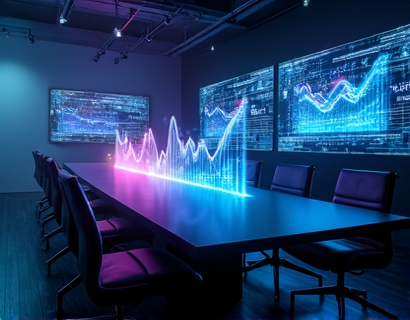Transforming Digital Experiences: The Synergy of Crypto and AI
The intersection of cryptocurrency and artificial intelligence (AI) is giving rise to a new era of digital innovation, where traditional boundaries are being redefined and user experiences are being transformed. This article delves into the transformative power of merging these two cutting-edge technologies to revolutionize digital interactions and enhance user experiences across various platforms and applications.
The integration of cryptocurrency and AI is not just a technological curiosity but a strategic move that promises to drive growth, engagement, and security in the digital landscape. As more businesses and developers recognize the potential of this synergy, the landscape is evolving rapidly, offering new opportunities and challenges. This comprehensive guide aims to explore the latest advancements in this field, providing insights into how these technologies are reshaping the way we interact with digital services.
Understanding Cryptocurrency and AI
To fully appreciate the transformative power of combining cryptocurrency and AI, it's essential to understand the fundamentals of each technology.
Cryptocurrency, often referred to as digital or virtual currency, uses cryptography for security and operates on a decentralized network, typically a blockchain. This decentralized nature eliminates the need for intermediaries, making transactions faster, cheaper, and more secure. Bitcoin, Ethereum, and numerous altcoins are leading examples of cryptocurrencies that have gained widespread adoption.
Artificial intelligence, on the other hand, involves the simulation of human intelligence processes by machines, particularly computer systems. These processes include learning (the acquisition of information and rules for using it), reasoning (using rules to reach approximate or definite conclusions), and self-correction. AI technologies such as machine learning, natural language processing, and computer vision are driving advancements across various industries.
The convergence of these two technologies creates a powerful toolkit for developing innovative solutions that can enhance user experiences, optimize operations, and ensure security in the digital realm.
Enhancing Security with Crypto and AI
One of the most significant benefits of merging cryptocurrency and AI is the enhancement of security measures in digital transactions and data protection. Traditional security methods often rely on centralized systems, which can be vulnerable to breaches and hacks. By leveraging the decentralized nature of blockchain and the advanced analytics capabilities of AI, a more robust security framework can be established.
AI can be used to monitor and analyze patterns in blockchain transactions, identifying potential fraudulent activities in real-time. Machine learning algorithms can detect anomalies and unusual behaviors, triggering alerts and automated responses to mitigate risks. This proactive approach to security not only protects users' assets but also builds trust in digital platforms.
Moreover, AI-driven cryptography can enhance the encryption of data, making it more resilient against cyber threats. Techniques such as homomorphic encryption, enabled by AI, allow computations to be performed on encrypted data without the need for decryption, ensuring data privacy and security throughout the processing cycle.
Optimizing User Experiences through AI-Powered Crypto Services
The integration of AI in cryptocurrency services can significantly improve user experiences by providing personalized, efficient, and intuitive interactions. For instance, AI-powered chatbots and virtual assistants can offer 24/7 customer support, answering queries, and guiding users through complex processes with ease.
Personalization is another area where AI shines. By analyzing user behavior and preferences, AI algorithms can tailor recommendations for crypto investments, wallet management, and transaction activities. This level of personalization not only enhances user satisfaction but also increases engagement and loyalty to the platform.
Furthermore, AI can optimize the user interface and experience by adapting to individual preferences and usage patterns. For example, AI-driven interfaces can dynamically adjust the layout, content, and features based on the user's behavior, making the platform more intuitive and user-friendly.
Smart Contracts and AI: A Powerful Combination
Smart contracts, self-executing contracts with the terms directly written into code, are a cornerstone of blockchain technology. When combined with AI, smart contracts can become even more powerful and versatile. AI can enhance the functionality of smart contracts by enabling them to make decisions based on complex data inputs and real-time conditions.
For instance, AI can be used to predict market trends, assess risks, and optimize contract execution. This can lead to more efficient and reliable smart contracts, reducing the need for intermediaries and lowering transaction costs. In the realm of decentralized finance (DeFi), AI-enhanced smart contracts can automate trading strategies, manage risk, and provide sophisticated financial services.
The synergy between smart contracts and AI also opens up new possibilities in the Internet of Things (IoT) and autonomous systems. AI-driven smart contracts can manage and coordinate interactions between various devices and systems, ensuring seamless and secure operations.
Data Analytics and Insights through Crypto and AI
Data analytics is a critical component of both cryptocurrency and AI ecosystems. The combination of these technologies can lead to unprecedented insights and decision-making capabilities. Blockchain's immutable and transparent nature, coupled with AI's advanced analytics, can provide a comprehensive view of data, from transaction patterns to user behavior.
AI can process and analyze large volumes of data from blockchain networks, extracting meaningful insights and patterns that would be impossible to discern manually. This can be particularly valuable in areas such as market analysis, fraud detection, and operational optimization. For businesses, these insights can inform strategic decisions, improve customer experiences, and drive innovation.
Moreover, AI can enhance the privacy and utility of data by implementing advanced anonymization techniques while still allowing for valuable analytics. This ensures that user data is protected while still providing actionable insights, aligning with the growing emphasis on data privacy and security.
Challenges and Considerations
While the potential of combining cryptocurrency and AI is vast, there are several challenges and considerations that need to be addressed. One of the primary concerns is the regulatory landscape. The decentralized and often anonymous nature of cryptocurrencies can pose challenges for regulators, who are still grappling with how to oversee these technologies effectively.
AI, on the other hand, raises ethical and privacy concerns, particularly around data usage and algorithmic bias. Ensuring that AI systems are transparent, fair, and accountable is crucial for gaining public trust and compliance with regulations. Developers and businesses must prioritize ethical AI practices and adhere to best standards to mitigate these risks.
Another challenge is the technical complexity involved in integrating these technologies. Developing robust and scalable solutions requires expertise in both blockchain and AI, which can be a barrier for some organizations. Collaboration between tech experts, researchers, and industry players is essential to overcome these technical hurdles and drive innovation.
Future Prospects and Innovations
The future of cryptocurrency and AI is bright, with numerous innovations on the horizon. One area of excitement is the development of AI-powered decentralized applications (dApps) that can offer more sophisticated and user-friendly experiences compared to traditional web applications.
Another promising direction is the integration of AI with other emerging technologies such as quantum computing and 5G networks. Quantum computing can enhance the computational power required for complex AI algorithms, while 5G can enable faster and more reliable connections for decentralized applications.
Additionally, the rise of non-fungible tokens (NFTs) and decentralized autonomous organizations (DAOs) presents new opportunities for leveraging the combined power of cryptocurrency and AI. AI can enhance the creation, management, and trading of NFTs, while DAOs can benefit from AI-driven decision-making and governance mechanisms.
As these technologies continue to evolve, the potential for transformative applications in various sectors, from healthcare and finance to education and entertainment, is immense. The key lies in fostering a collaborative ecosystem where innovation can thrive, and the benefits of these advancements can be widely shared.
In conclusion, the merging of cryptocurrency and AI is not just a technological trend but a fundamental shift in how we approach digital interactions and user experiences. By harnessing the strengths of both technologies, we can create more secure, efficient, and engaging digital platforms that drive growth and innovation in the evolving tech landscape.











































